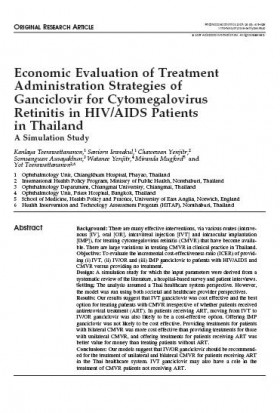This website uses cookies so that we can provide you with the best user experience possible. Cookie information is stored in your browser and performs functions such as recognising you when you return to our website and helping our team to understand which sections of the website you find most interesting and useful.
Economic evaluation of treatment administration strategies of ganciclovir for cytomegalovirus retinitis in HIV/AIDS patients in Thailand: a simulation study. (2007)

รายละเอียดเพิ่มเติม
Economic evaluation of treatment administration strategies of ganciclovir for
cytomegalovirus retinitis in HIV/AIDS patients in Thailand: a simulation study.
Teerawattananon K1, Iewsakul S1, Yenjitr C2, Ausayakhun S3, Yenjitr W4, Mugford M5, Teerawattananon Y2,6.
1 Ophthalmology Unit, Chiangkhum Hospital, Phayao, Thailand
2 International Health Policy Program, Ministry of Public Health, Nonthaburi, Thailand
3 Ophthalmology Department, Chiangmai University, Chiangmai, Thailand
4 Ophthalmology Unit, Priest Hospital, Bangkok, Thailand
5 School of Medicine, Health Policy and Practice, University of East Anglia, Norwich, England
6 Health Intervention and Technology Assessment Program (HITAP), Nonthaburi, Thailand
Backgroud
There are many effective interventions, via various routes (intravenous (IV), oral (OR), intravitreal injection (IVT) and intraocular implantation (IMP)), for treating cytomegalovirus retinitis (CMVR) that have become available. There are large variations in treating CMVR in clinical practice in Thailand.
Objectives
To evaluate the incremental cost-effectiveness ratio (ICER) of providing (i) IVT, (ii) IV/OR and (iii) IMP ganciclovir to patients with HIV/AIDS and CMVR versus providing no treatment.
Design
A simulation study for which the input parameters were derived from a systematic review of the literature, a hospital-based survey and patient interviews.
Setting
The analysis assumed a Thai healthcare system perspective. However, the model was run using both societal and healthcare provider perspectives.
Results
Our results suggest that IVT ganciclovir was cost effective and the best option for treating patients with CMVR irrespective of whether patients received antiretroviral treatment (ART). In patients receiving ART, moving from IVT to IV/OR ganciclovir was also likely to be a cost-effective option. Offering IMP ganciclovir was not likely to be cost effective. Providing treatments for patients with bilateral CMVR was more cost effective than providing treatments for those with unilateral CMVR, and offering treatments for patients receiving ART was better value for money than treating patients without ART.
Conclusions
Our models suggest that IV/OR ganciclovir should be recommended for the treatment of unilateral and bilateral CMVR for patients receiving ART in the Thai healthcare system. IVT ganciclovir may also have a role in the treatment of CMVR patients not receiving ART.
Link:




